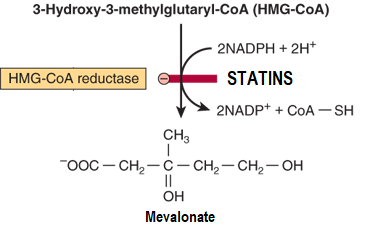Statins comprise a group of drugs that are widely prescribed to combat high cholesterol. They suppress the production of cholesterol in the liver and interfere with the formation of plaques in the arteries of the body. As such, these cholesterol-lowering drugs help to reduce various cardiovascular illnesses (for example, heart disease, atrial fibrillation, and stroke) and death. See also: Atrial fibrillation; Cholesterol; Heart disorders; Liver

Specifically, a statin reduces the level of low-density lipoprotein (LDL) cholesterol (the "bad" form of cholesterol) in the blood. The drug is cleared from the bloodstream into the liver, where it partially inhibits the activity of 3-hydroxy-3-methylglutaryl coenzyme A (HMG-CoA) reductase, which is the rate-limiting enzyme of cholesterol synthesis. In addition, through a number of interconnected biochemical steps and processes, the liver increases the number of LDL receptors, leading to a greater removal of LDLs from the bloodstream. Importantly, this reduction in the blood's LDL cholesterol levels can limit the risk of a heart attack. See also: Cholesterol and the SREBP pathway; Cholesteryl ester transfer protein (CETP); Lipoprotein
The creation of statins from various fungal sources is a very active line of investigation. Fungi, including yeasts, are an extremely diverse group of organisms, and they exhibit numerous biosynthetic and biodegradative activities. Because fungi can trigger chemical changes in natural or synthetic organic molecules, many species have been examined specifically for biotechnological and pharmaceutical applications. For example, the fungus Monascus, which is found in red yeast rice, contains various monacolins, which are active compounds in statins. See also: Fungal biotechnology; Fungi; Pharmaceutical chemistry; Pharmaceuticals testing; Pharmacology; Recombinant fungal biotechnology; Red yeast rice; Yeast
In addition, statins may have a number of other beneficial effects, being able to fight against diseases for which they were not originally intended. In particular, statins can potentially suppress tumor growth, and they have been found to fight against cancer, pneumonia, chronic inflammation, arthritis, and influenza. They also may have application as vaccine adjuvants [chemicals that enhance the potency of antigens (substances that cause the immune system to produce specific antibodies or T cells against them)]. However, side effects are often a problem. For example, research has pointed to a link between statin usage and musculoskeletal conditions, including joint diseases and injuries. There also may be a connection between statins and neurological problems, including memory loss. Therefore, a fuller analysis of the use of statins to combat a variety of diseases and medical conditions is necessary, but signs point to an encouraging and expanding prospect. See also: Bone disorders; Cancer; Inflammation; Influenza; Joint disorders; Muscular system disorders; Tumor; Vaccination





